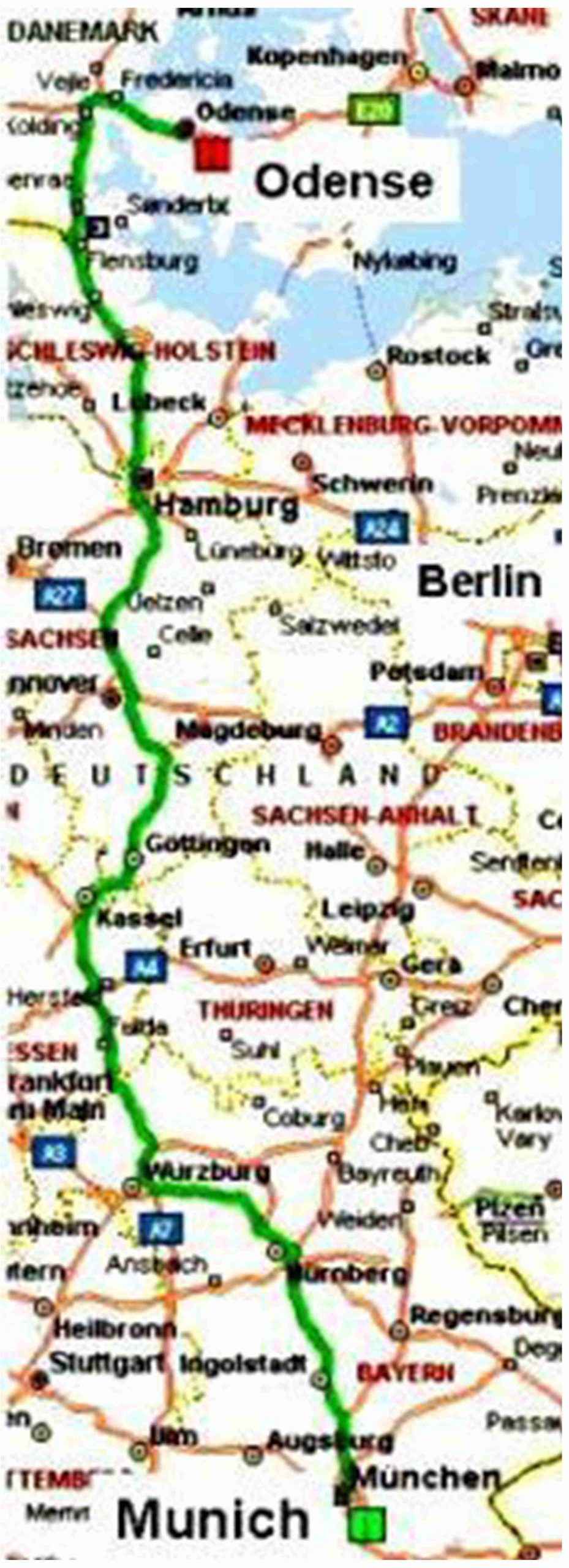After transition from Transputers to the Power-PC 601 as numerical processor in the transputer system, which brought about an increase in computing power by one order of magnitude per microprocessor, this long distance test has been performed to obtain statistical data on system performance. More than 1600 km have been driven with autonomous longitudinal and lateral visual guidance based on black-and-white image evaluation using the edge extractor CRONOS (M.1 Visual perception of motion in real-time). Speeds up to 180 km/h have been demonstrated on a free stretch of Autobahn in the northern plain (Lueneburger Heide).
This test also was a response to the CMU-NavLab5 test run “Hands-off through America” earlier in the year; with visual guidance by computers only in the lateral degrees of freedom; ~ 98% of the distance (> 5000) km have been run autonomously in that mode.
Statistics of the VaMP test-run Munich – Odense (Nov. 1995, green route in figure)
Speeds driven varied between 60 and 180 km/h (top right part); usual speeds were between 80 and 130 km/h. At the top speed driven in the northern plain (Lueneburger Heide, low traffic density) the safety driver was in charge of early detection of obstacles far away.
The statistic of distances driven fully autonomously [lower figure left (a)] shows that even with the relatively simple feature extraction method used
- VaMP has been able five times to drive distances of more than 100 km without interruption (red rectangle lower center);
- the longest stretch was ~ 160 km.
- The lower right part (b) of the figure shows that lateral deviations very rarely exceeded ± 0.2 m from the lane center.
- More than 400 lane changes have been performed autonomously, triggered by the human safety driver (the rear hemisphere has not been observed by machine vision in the Power-PC 601-version).
As a result, the following six items have been recognized as needing improvement in the next-generation system:
- A wider simultaneous field of view nearby,
- the capability of stereo vision nearby in a small locatable field of view,
- a high-resolution component for early obstacle detection at larger distances in high speed driving (stronger tele-lens),
- more robust detection and tracking of edge features as well as region-based features and corners,
- color detection and interpretation; this is very essential at construction sites (with yellow lines beside the usual white ones) and for traffic sign interpretation. In a multi-camera system not all cameras need to have color sensing.
- Above all, the main conclusion was that the next-generation system should have quality evaluation- and error detection capabilities at all levels, from feature detection, object recognition and tracking, to situation assessment and behavior decision.
References
Behringer R (1996). Visuelle Erkennung und Interpretation des Fahrspurverlaufes durch Rechnersehen für ein autonomes Straßenfahrzeug. Dissertation, UniBwM / LRT. Kurzfassung
Behringer R, Maurer M (1996). Results on Visual Road Recognition for Road Vehicle Guidance. In Masaki (ed): Proc. of Int. Symp. on Intelligent Vehicles ’96, Tokyo, pp 415-420
Maurer M (2000). Flexible Automatisierung von Strassenfahrzeugen mit Rechnersehen. Dissertation, UniBwM / LRT
Dickmanns ED (2007). Dynamic Vision for Perception and Control of Motion. Springer-Verlag, (Section 9.4.2.5) Content
